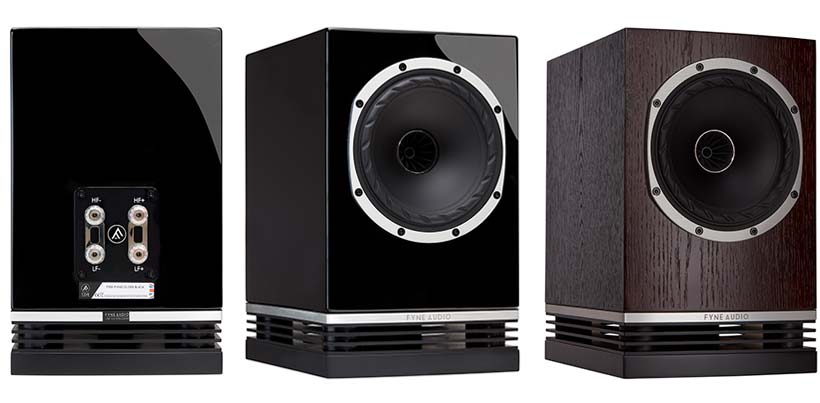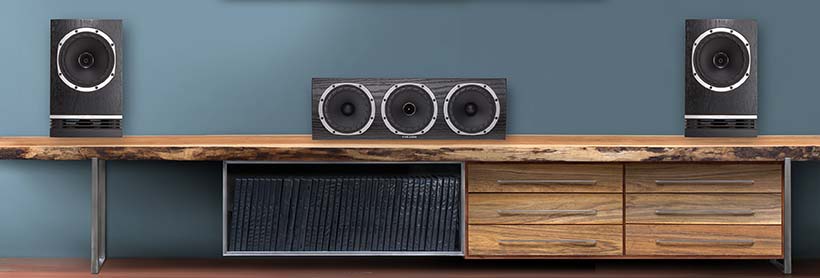I first heard the then recently-launched Fyne brand at a breakaway show in Munich, staged in the upmarket Marriott hotel a few miles away from the main event at the MoC complex. It is a firm I was interested in since, in reality, it has its routes in Guy Fountain’s legendary Tannoy company which dates back to 1926 and made a move to Scotland in the 1970s which is where I was proud to visit as a young hack on Hi-Fi News & Record Review on several occasions.
Tannoy was acquired by Music Group which ended up selling the Scottish site and moving the bulk of manufacture to China where cheaper models had already been in production for the best part of two decades. Key executives left and came together to create Fyne Audio in August 2016.
Close to the entry-point of the Fyne line-up is the F500, a compact two-way bookshelf designed in the UK but constructed in the Far East. Some smart-looking matching stands also available but were not supplied for the review. I resorted to some lightweight and open wooden stands of a height to bring the centre of the main drive unit, and thus the tweeter, to ear level so that I would be listening on-axis.

Technology
The F500 is oozing with technology. This series of three models is based around an Iso-Flare point-source drive unit; something the company’s technical guru Dr Paul Mills is well renowned for. I was a keen advocate of the dual-concentric cones of old. This dual drive unit is mounted in a wood veneered cabinet boasting plenty of rigidity and an unusual down-firing porting system intended to improve in-room performance. Finish options are wide, including black oak as supplied along with piano gloss white or black, or dark oak. Bi-wire binding posts are even provided although they remained ‘linked’ for the review.
Several proprietary technologies are included such as the BassTrax port system comprising an internal, downwards-firing port system. Below the port, a Tractrix profile diffuser (patent applied for) converts plain wave port energy to a spherical 360-degree wave front, integrating energy uniformly into the room. This clever design ensures that the loudspeaker is less critical of room positioning.
Among areas with attention-to detail is the crossover, where low-loss, laminated core inductors and audiophile-grade polypropylene capacitors have been deployed in an effort to create a clean signal path and very low crossover losses in the name of detail resolution and what Fyne call “musical communication”.
The F500 range has been conceived with home theatre use in mind and we are advised that its point source driver technology is: “ideal for articulating the finest of movie detail with pin-point accuracy”. Another pre-requisite in the design has been high efficiency and high-power handling because Fyne’s engineers were seeking “incredibly dynamic and lifelike performance” from movie soundtracks, with both DTS Master Audio and Dolby True HD in mind.

That point-source idea is worthy of further investigation, if not an entire article. It is expertise the former Tannoy engineers brought with them to Fyne. Here the IsoFlare design is intended to ensure a constant directivity of the wavefront generated, the idea being to create the best possible stereo imaging, even when listening off-axis. The trade-marked technology also boasts a smooth and extended response from the highly-rigid titanium HF diaphragm which pushes the break-up mode out of the audible range.
The tweeter has a vented rear chamber in its neodymium magnet to place LF resonance below the crossover. Geometry of the HF driver’s waveguide has been created to provide a flat frequency response while avoiding internal reflections. The model’s white paper goes into more detail: “To eliminate unwanted vibrations, which would be detrimental to the sound quality, both the point source driver and the supplementary low frequency driver fitted to the floor standing models, are built around a rigid cast aluminium chassis. Multi-fibre paper cones are used providing natural sounding midrange and clean transient behaviour. Cone energy is then very effectively terminated using a fluted rubber surround.”
Sound quality
Having had the newly-launched Trigon Exxceed integrated on test for a few weeks (enthusiastically reviewed – Ed) it seemed natural to connect up the F500s in place of a range of speakers costing up to ten-times as much. How would these modest bookshelf units fair when coupled to a highly-competent amp which generates far more output power than the subordinate F500s need.

I felt my initial reactions to be a subconscious comparison with the previous speakers I had been using, so went away for a week and came back to the Fyne units. With fresh ears, as it were, it’s clear that here are some competently engineered speakers with a high build quality. Room placement could not have been simpler. In fact, virtually no matter where I plonked the F500s they performed without room-induced issues. I never managed to extract much low-end grunt, but the cabinet volume is meagre. This was noted especially on one of my test albums, Phil Collin’s But Seriously.
I didn’t manage to extract as much punch as I might have liked and a mild ‘boxiness;’ was apparent on some of my favourite choral pieces, such as Boult’s 1976 Dream of Gerontius on EMI where the scale appeared somewhat diminished and the overall performance slightly congested from its usual rendition, albeit on more expensive speakers. Spoken word, too, suffered at the hands of the F500s, with Iain Carmichael taking on a chestiness as Lord Peter Wimsey in the BBC Drama production of Have His Carcase while Maria Aitken, as Harriet Vane, lost some of her usual sparkle and air.
The metallic membrane of the HF unit was audible on some tracks such that HF frequencies could be over-excited, noted especially with several female vocalists, among them Alison Moyet whose Raindancing was projected forward in what, to me, was an unnatural presentation. The treble produced could not be described as harsh, as such, it was just too prominent for my taste – especially so in relation to the midrange.

The designer has to set-out to create a product for a particular audience and this one wasn’t really cup of tea; but, as with almost everything subjective it’s a matter of personal taste and I have no doubt that the F500s will be enjoyed by those whom it was intended for. I am reminded of a rave review I gave to some speakers decades ago now and, when meeting another reviewer on the road, he mentioned my article. “Wow, yes”, I said. “They were amazing, so analytical.” “Um”, he replied. “They weren’t musical though.” So, it’s horses for courses with transducers, as with much else and a personal audition is required.
Conclusion
There is nothing particularly ‘wrong’ with these loudspeakers; in fact they have their positives – but just not enough positives to get me really excited and hooked on the sound.
Yes, they produced a well-focussed sound and didn’t seem too bothered by room placement. Yes, they are solidly made and well engineered. The enclosures are pretty small and so bass extension is not amazing and I can’t claim to have achieved the stated 45Hz in-room response. What was missing to my mind was any real punch, a get-up-and-go feeling so that the feet begin to tap involuntarily. That said, I know that this marque is capable of better, much better, because I heard it so in Munich. Here’s to some of the Scottish-manufactured models providing more chutzpah, to give Fyne another chance.


